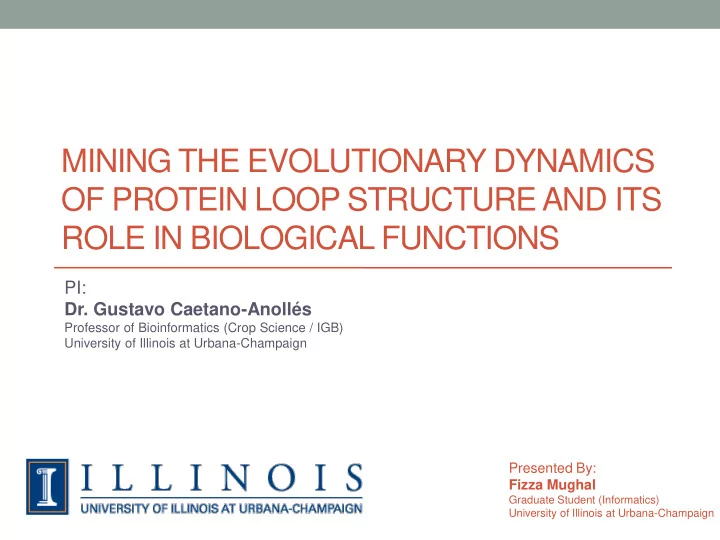

MINING THE EVOLUTIONARY DYNAMICS OF PROTEIN LOOP STRUCTURE AND ITS ROLE IN BIOLOGICAL FUNCTIONS PI: Dr. Gustavo Caetano-Anollés Professor of Bioinformatics (Crop Science / IGB) University of Illinois at Urbana-Champaign Presented By: Fizza Mughal Graduate Student (Informatics) University of Illinois at Urbana-Champaign
Objectives • Flexible-unstructured regions of proteins introduce fundamental heterogeneity for molecular function • Exploring dynamics of loops to ascertain their role in protein function • Identify protein motions exclusive to specific functions • Examine biophysical properties (flexibility and fluctuations) in the light of evolution Source: Source: http://www3.mpibpc.mpg.de/groups/ Kruse, E., et al. 2006. Genome de_groot/compbio1/p5/index.html Biology , 7 (2), 206
Protein Structure • Levels • Primary • Secondary • Tertiary • Quaternary • Domains: folded stable units • Structural Classification Of Proteins (SCOP) • Fold Families: recent common ancestry • Fold Super Families: distant common ancestor • Folds: common structural topology Source: http://en.wikipedia.org/wiki/Protein_structure
Protein Molecular Function • Gene Ontology (GO): • Cellular Component • intracellular or extracellular • Molecular function • Binding or catalysis • Biological Process • Operations critical to functioning of living units Source: Ouzounis, et al. , 2003 Nature Reviews Genetics , 4 (7), 508-519.
Protein Evolution • Assumption: • Most abundant = most ancient • Phylogenomic reconstruction • Characters • Taxa FF Assignment 1. Genomic Abundance 2. calculation Character states defined (N= 3. most ancient; 0= most recent) and polarized Tree construction using 4. PAUP* (maximum parsimony) Age (node distance, nd ) 5. calculated (0=most ancient; 1=most recent) Source: Kim & Caetano-Anollés, 2012. BMC evolutionary biology , 12 (1), 13.
Approach • Dataset • Aminoacyl-tRNA synthetase (aaRS) domain FFs • ArchDB loop classification • Annotation with nd values • 87 Classifications • Density Search (DS) • Lowest p-value • Loop length >2 AA • Sec struc length ≥ 8 AA • Overall length < ~40 AA • MD Simulations (NPT) • NAMD 2.9 • CHARMM36 Source: Caetano-Anollés, et al. ,2013. PLoS One , 8 (8), e72225..
Why Blue Waters? • Computing capability • Storage of temporary files • Impact: International Collaboration • Key Challenge: Output File Storage
The Journey So F ar … • 73 Simulations performed • Associated molecular functions • Example: b.40.4.4 (MyF domain) • Global Parameters: • RMSD • Radius of gyration Classification FF Loop ID Loop Length GO Term Molecular Function DS.BN.3.13.1 b.40.4.4 1JMZ_A_182 3 GO:0020037 Heme binding GO:0046872 Metal ion binding GO:0009055 Electron carrier activity DS.BN.4.2.13 b.40.4.4 1T77_A_2080 4 None None DS.BN.5.2.2 b.40.4.4 1FJR_A_36 5 GO:0004930 G-coupled receptor protein activity DS.BN.6.69.1 b.40.4.4 4MLL_B_208 6 GO:0008800 Beta-lactamase activity GO:0008658 Penicillin binding
Conformational diversity (RMSD) vs. evolutionary age (nd) 14 12 10 8 RMSD 6 4 2 0 0 0.1 0.2 0.3 0.4 0.5 0.6 0.7 0.8 0.9 1
Radius of Gyration vs. age (nd) 16 14 12 10 8 Rad_gyr 6 4 2 0 0 0.1 0.2 0.3 0.4 0.5 0.6 0.7 0.8 0.9 1
1JMZ
• 1JMZ
Conclusion & Future Directions • Identification of fundamental principles of molecular evolution is achieved by reconstructing past events • Advances in synthetic biology and translational medicine • M ethods to predict future “evolutionary trajectories” • predict evolvability of viruses • treatment of viral diseases with interfering agents (Wilke, 2012 PLoS computational biology ) • Map motions specific to classification/function based on molecular dynamic simulations • Energy analysis • Expand the data set!
Acknowledgements • NCSA Blue Waters • Illinois Research Board Grant • Dr. Frauke Gräter (Germany) • Evolutionary Bioinformatics Lab Members
THANK YOU! Questions/Comments/Suggestions
Recommend
More recommend